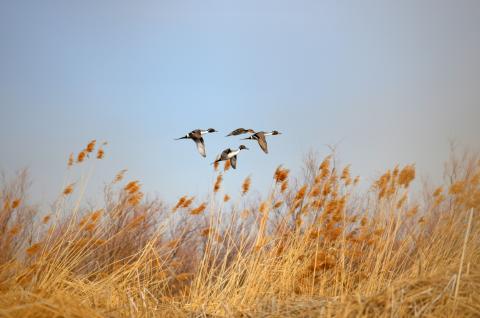
Have Fun While Giving Back
Waterfowl Slam enters its fourth year
You can add fun and challenge to your duck and goose hunts this season by joining Utah’s Waterfowl Slam. In the process, you’ll provide funding that helps the birds, Utah’s wetlands and yourself.
“Every penny that’s raised goes directly into habitat work that benefits waterfowl and creates new areas to hunt,” says Blair Stringham, migratory game bird coordinator for the Division of Wildlife Resources. “The slam is a great way to add fun and challenge to your hunt while giving back to waterfowl and wetlands.”
Stringham provides a brief overview of the program. He also talks about the ways the DWR has used money raised through the slam.
Utah Waterfowl Slam
Utah has nine waterfowl slams. Each time you complete one, you’ll receive a colorful leg band that you can place on your call lanyard or anywhere you’d like to keep it.
Most of the slams focus on taking male ducks, called drakes, within a certain time frame. For example, to earn a band in the Mallard Slam, you must take a limit of seven drake mallards in a single day. You have the entire season to complete the Puddler Slam, but don’t let the amount of time you have trick you: in addition to an American coot, you must take a drake from each of the seven puddle duck species most commonly found in Utah (mallard, northern pintail, American wigeon, gadwall, cinnamon teal, green-winged teal and Northern shoveler).
Waterfowl Slam memberships cost $20 for hunters older than 17, and $10 for those 17 years of age and younger. Memberships must be renewed annually.
“What’s neat about the program is that for every dollar a hunter pays to join, the federal government gives us three dollars in return,” Stringham says. “For example, if you’re an adult, and you pay the $20 fee to join the program, the DWR, in return, gets $60 in federal funds. So, by paying $20, you’re actually providing $80 for on-the-ground work that helps waterfowl and other wildlife.”
You can learn more about the slam, and sign up to participate, at www.wildlife.utah.gov/utah-waterfowl-slam.
Two new hunting areas
Using money provided through the Waterfowl Slam by hunters, matching federal dollars and funding from Fowl Minded and the Division of Forestry, Fire & State Lands, the DWR has completed one project and is close to completing another:
Farmington Bay Waterfowl Management Area – J-dike Unit
The J-dike project—a brand new wetland for birds—started in 2016. The impoundment, which is now called Teal Lake, is about 280 acres in size. It’s directly west of the main dike on Unit 1. The newly constructed dike at Teal Lake has five water control structures that allow managers to move water out of the unit as needed.
Jason Jones, manager of the Farmington Bay WMA, says the unit, which was infested with phragmites, was chemically treated by helicopter in August. This winter, after the unit freezes and is drained, the phragmites will be mowed and crushed. Next spring, the area will be re-flooded to its maximum height.
“Raising the level will help us maintain open water,” Jones says, “and that will help us bring the native vegetation back.”
Currently, a long-reach track-hoe is busy improving the new dike. Next spring, Jones hopes to spread gravel on top of the dike and plant native vegetation along the front and back of the dike, further improving access and the aesthetics and longevity of the unit.
“In the meantime,” Jones says, “birds are using open pockets of water along the dike. And, if you’re willing to break through the phragmites, open pockets of water are available in the middle of the unit.
“Once the phragmites is under control,” he says, “the entire unit should provide excellent habitat for birds and great hunting for waterfowl enthusiasts.”
Ogden Bay Waterfowl Management Area – North Run
This season, a new impoundment, more than 100 acres in size, is waiting for you on the north end of the Ogden Bay WMA.
Before the project started in 2016, phragmites and salt cedar dominated the area. The only way the area could receive water was through rainfall and spring runoff.
Rich Hansen, manager of the Ogden Bay WMA, says funding was used to raise the roads at North Run two feet. A new linear dike, more than 6,000 feet long, was also built.
“The raised roads and the new dike form an impoundment that allow us to keep water in the area,” he says. “Water control structures in the new dike allow us to flood the area to depths that will help us better control the phragmites and allow the native vegetation to return.”
As the general hunting season approaches, Hansen says improved habitat in the unit is already drawing birds to the area. Most of the water is fairly shallow, but if you hunt the unit this fall, please be aware that the water near the islands is somewhat deeper than the water depth elsewhere in the unit.
The new unit is directly west of the parking lot at North Run. To reach the unit, travel on Interstate 15 to the Ogden 12th Street exit. After exiting the freeway, turn west on 1200 North, and travel west until you reach 7500 West. Turn south on 7500 West, and travel down the road to the parking lot.
Fishing reports - available at http://wildlife.utah.gov/hotspots .